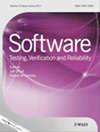Sidereal:统计自适应生成健壮的web测试定位器
IF 1.2
4区 计算机科学
Q3 COMPUTER SCIENCE, SOFTWARE ENGINEERING
引用次数: 11
摘要
通过确保足够的功能覆盖,端到端(E2E)测试是持续集成的关键促成因素。对于web应用程序更是如此,在web应用程序中,自动化的端到端测试是测试用于创建现代应用程序的完整堆栈的唯一方法。用于web测试的测试代码通常依赖于DOM定位器(通常表示为XPath表达式)来识别web元素并提取断言中检查的数据。当应用程序发展时,测试代码发展的最主要成本是由于损坏的定位器,它无法定位新版本中的目标元素,必须修复。在本文中,我们将健壮的XPath定位器生成问题描述为一个图探索问题,而不是依赖于由最先进的工具robula+实现的临时启发式。我们的方法基于由工具sidereal实现的统计自适应算法,该算法通过从被测应用程序的先前版本中学习HTML属性的潜在脆弱性,在鲁棒性方面优于robula+的启发式算法。sidereal应用于六个应用程序,总共611个定位器,并与robula+和Montoto两种基线算法进行了比较。采用sidereal可显著减少定位器损坏的数量(分别为- 55%和- 70%)。产生这种强大的定位器的时间被认为是可以接受的,在百分之一秒的数量级。本文章由计算机程序翻译,如有差异,请以英文原文为准。
Sidereal: Statistical adaptive generation of robust locators for web testing
By ensuring adequate functional coverage, End‐to‐End (E2E) testing is a key enabling factor of continuous integration. This is even more true for web applications, where automated E2E testing is the only way to exercise the full stack used to create a modern application. The test code used for web testing usually relies on DOM locators, often expressed as XPath expressions, to identify the web elements and to extract the data checked in assertions. When applications evolve, the most dominant cost for the evolution of test code is due to broken locators, which fail to locate the target element in the novel versions and must be repaired. In this paper, we formulate the robust XPath locator generation problem as a graph exploration problem, instead of relying on ad‐hoc heuristics as the one implemented by the state of the art tool robula+. Our approach is based on a statistical adaptive algorithm implemented by the tool sidereal, which outperforms robula+'s heuristics in terms of robustness by learning the potential fragility of HTML properties from previous versions of the application under test. sidereal was applied to six applications and to a total of 611 locators and was compared against two baseline algorithms, robula+ and Montoto. The adoption of sidereal results in a significant reduction of the number of broken locators (respectively ‐55% and ‐70%). The time for generating such robust locators was deemed acceptable being in the order of hundredths of second.
求助全文
通过发布文献求助,成功后即可免费获取论文全文。
去求助
来源期刊

Software Testing Verification & Reliability
工程技术-计算机:软件工程
CiteScore
3.70
自引率
0.00%
发文量
34
审稿时长
>12 weeks
期刊介绍:
The journal is the premier outlet for research results on the subjects of testing, verification and reliability. Readers will find useful research on issues pertaining to building better software and evaluating it.
The journal is unique in its emphasis on theoretical foundations and applications to real-world software development. The balance of theory, empirical work, and practical applications provide readers with better techniques for testing, verifying and improving the reliability of software.
The journal targets researchers, practitioners, educators and students that have a vested interest in results generated by high-quality testing, verification and reliability modeling and evaluation of software. Topics of special interest include, but are not limited to:
-New criteria for software testing and verification
-Application of existing software testing and verification techniques to new types of software, including web applications, web services, embedded software, aspect-oriented software, and software architectures
-Model based testing
-Formal verification techniques such as model-checking
-Comparison of testing and verification techniques
-Measurement of and metrics for testing, verification and reliability
-Industrial experience with cutting edge techniques
-Descriptions and evaluations of commercial and open-source software testing tools
-Reliability modeling, measurement and application
-Testing and verification of software security
-Automated test data generation
-Process issues and methods
-Non-functional testing
 求助内容:
求助内容: 应助结果提醒方式:
应助结果提醒方式:


